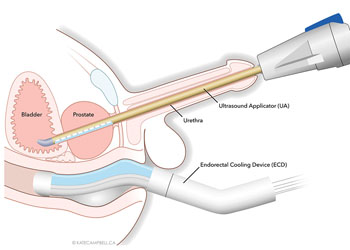MRI-Guided Ultrasound Procedure Ablates Entire Prostate Gland
By MedImaging International staff writers
Posted on 29 Apr 2016
A real-time, magnetic resonance imaging (MRI) guided ultrasound system provides a continuous volume of thermal energy to ablate the prostate gland from the inside out.Posted on 29 Apr 2016
The transurethral ultrasound ablation (TULSA) PRO system is based on an ultrasound applicator (UA) that houses 10 transducers, which can be individually turned on or off, depending upon the size of the prostate gland. During treatment, the UA is inserted into the urethra and rotated 360 degrees while emitting highly accurate and precise ultrasound energy. The energy thermally coagulates the prostate gland outwards from the urethra towards the prostate boundary, thus destroying the prostate tissue (including the cancerous tissue), but sparing surrounding healthy tissue. An auxiliary endorectal cooling device provides further protection.

Image: The transurethral ultrasound ablation (TULSA) PRO system (Photo courtesy of Profound Medical).
The procedure takes place within an MRI scanner, during which a software-controlled algorithm measures MRI temperature data to adjust the energy intensity and rate of rotation of the UA, resulting in precise conformal targeting and temperature feedback. The minimally invasive procedure takes about 40 minutes, and can be performed on an outpatient basis, with the same (or better) quality outcomes than surgery or radiation. The TULSA PRO system is a product of Profound Medical (Toronto, ON, Canada), and has received the European Community (EC) mark of approval.
“Our preclinical data observed that 83% of urethral tissue was preserved after treatment, along with no damage to urethral sphincters, bladder neck, or rectal wall, resulting in good quality of life outcomes,” said Steven Plymale, CEO of Profound Medical. “Twelve-month follow-up of 30 patients demonstrated virtually no incidence of incontinence and GI toxicity. We’re also now seeing rates of erectile dysfunction at around 16% with TULSA-PRO, well below rates following surgery.”
The TULSA system works differently to another innovative prostate ablation procedure, high intensity-focused ultrasound (HIFU), which uses a rectal probe to emit a HIFU beam through the rectal wall to the prostate, creating a rice-sized lesion. While HIFU needs to lays down hundreds of rice-sized lesions, one on top of the other, ablating 40 cubic centimeters of prostate tissue in three hours, the transurethral TULSA-PRO probe does a single sweep in 40 minutes, covering an area as large as 100 cubic centimeters.
Related Links:
Profound Medical














